Physical Address
304 North Cardinal St.
Dorchester Center, MA 02124
Accurate assignment of gestational age to a pregnancy is important for several reasons, including timing of screening tests for aneuploidy, monitoring fetal growth and diagnosing growth disturbances, and scheduling of delivery by elective induction or cesarean.
If a woman has more than one sonogram during her pregnancy, the pregnancy should not be redated after the first scan; instead, the gestational age at the time of subsequent scans is the age at initial scan plus the time elapsed since that scan.
In the first trimester, dating by sonographic findings or mean sac diameter prior to 6.0 weeks' gestation has an accuracy of ±0.5 weeks, while dating by crown-rump length at 6.0 weeks or later has an accuracy of ±0.7 weeks.
Sonographic dating in the second and third trimesters has an accuracy of ±1.2 weeks at 14 to 20 weeks, ±1.9 weeks at 20 to 26 weeks, ±3.1 to 3.4 weeks at 26 to 32 weeks, and ±3.5 to 3.8 after 32 weeks.
Fetal weight is estimated using a formula that incorporates measurements of the fetal head, abdomen, and femur and has an accuracy (95% confidence range) of ±15% to 18%.
Estimated fetal weight should be assessed in relation to gestational age to determine whether the fetus is appropriate in size for gestational age.
If a fetus is diagnosed as small-for-gestational-age, with an estimated fetal weight less than 10th percentile for gestational age, an attempt should be made to determine the cause through evaluation of both mother and fetus.
When a fetus is suspected of being growth restricted, antenatal surveillance with biophysical profiles and fetal Doppler can guide management and improve outcome.
Sonographic measurements of the fetus provide information about fetal age and growth. These data are used to assign gestational age, estimate fetal weight, and diagnose growth disturbances. As discussed in other chapters, fetal measurements are also used in the diagnosis of a number of fetal anomalies, such as skeletal dysplasias and microcephaly. Each of these abnormalities can be diagnosed or suspected on the basis of measurements that deviate from the “normal for dates.”
It is important to begin by defining the various terms used in the evaluation of the age of a pregnancy. The true measure of a pregnancy's age is the number of days since conception, termed conceptual age. Historically, however, pregnancies were dated by the number of days since the first day of the last menstrual period (LMP), termed menstrual age, because for most of human history it was unknown when conception occurred. In women with regular 28-day cycles, menstrual age is 2 weeks more than conceptual age, because conception occurs approximately 2 weeks after the LMP in such women. Currently, the term most often used to date pregnancies is gestational age, which is similar to menstrual age and is defined as follows:
In women with 28-day cycles, gestational age and menstrual age are equal. In women with longer cycles, gestational age is less than menstrual age; the opposite holds in women with shorter cycles.
Accurate knowledge of gestational age is important for a number of reasons. The timing of screening tests in the first trimester, such as nuchal translucency measurement and maternal cell free fetal DNA analysis, genetic amniocentesis in the second trimester, and elective induction or cesarean delivery in the third trimester are all based on the gestational age. The differentiation between term and preterm labor and the characterization of a fetus as “postdates” depend on gestational age. Knowledge of the gestational age can be critical in distinguishing normal from pathologic fetal development. Midgut herniation, for example, is normal up to 11 to 12 weeks of gestation but signifies omphalocele thereafter. The normal size of a variety of fetal body parts depends on gestational age, as do levels of maternal serum alpha-fetoprotein, human chorionic gonadotropin, and estriol. When a fetal anomaly is detected prenatally, the maternal choices and obstetric management are significantly influenced by gestational age.
Estimation of the fetal weight, on its own and in relation to the gestational age, can influence obstetric management decisions concerning the timing and route of delivery. A fetus growing poorly may benefit from close monitoring of fetal well-being to determine if early delivery is indicated. Such a fetus may be inadequately supplied by its placenta with oxygen and nutrients and, therefore, may do better in the care of a neonatologist than in utero. When a fetus is large, cesarean may be the preferred route of delivery, particularly in pregnancies complicated by maternal diabetes. In view of these considerations, fetal measurements should be a component of every complete obstetric sonogram.
The well-being of the fetus at risk for perinatal morbidity and mortality, such as a growth-restricted fetus, can be monitored by ultrasound using the biophysical profile and Doppler. Abnormalities and changes in any of these surveillance tests may guide decisions about timing of delivery.
Clinical dating of a pregnancy is usually based on the patient's recollection of the first day of her LMP and on physical examination of uterine size. Unfortunately, both of these methods are imprecise, leading to inaccuracies in gestational age assignment. Dating by LMP (menstrual age) may be inaccurate because of variability in length of menstrual cycles, faulty memory, recent exposure to oral contraceptives, or bleeding during early pregnancy. Determining gestational age from the palpated dimension of the uterus may be affected by uterine fibroids, multiple pregnancy, and maternal body habitus.
Clinical dating is accurate only if either of the following two conditions apply: (1) the patient is a good historian with regular menstrual cycles, and the uterine size correlates closely with LMP; or (2) information is available specifying the time of conception, such as a basal body temperature chart or pregnancy achieved via assisted reproductive technologies in women treated for infertility.
Ultrasound provides an alternative and, in many cases, superior approach to gestational age estimation. Sonographic age estimation is based on sonographic findings or measurements taken during the ultrasound examination. Because biologic variability in the size of fetuses increases as pregnancy progresses, the accuracy of sonographic age estimates declines as pregnancy proceeds. Thus, if a woman has more than one sonogram during a pregnancy, the pregnancy should never be redated after the first scan.
The decision as to whether to use clinical dating or sonographic dating at the time of the first scan is not well established for all pregnancies. In some cases, though, the decision is clear-cut: pregnancies achieved via in vitro fertilization should be dated based on the embryo transfer dates, and naturally conceived pregnancies in women with irregular menstrual cycles or with poor recollection of their LMP should be dated based on sonographic criteria. In other situations, however, particularly for pregnancies conceived naturally in women with regular cycles and good recollection of LMP, there are two reasonable alternatives. The first approach is to date the pregnancy based on LMP whenever the ages based on LMP and sonography are close to one another: within 5 days up to 8.9 weeks; within 7 days from 9.0 weeks to 15.9 weeks; within 10 days from 16.0 weeks to 21.9 weeks; within 14 days from 22.0 weeks to 27.9 weeks; and within 21 days from 28.0 weeks onward. An alternative approach is to use sonographic dating routinely up to 24 weeks and the LMP thereafter, if the LMP is clearly recalled and within 21 days of sonographic dating.
Whichever approach is used, it is important to know what sonographic criteria are available for gestational age estimation and which are the most accurate at each stage of pregnancy.
Sonographic findings and measurements allow highly accurate dating from 5 weeks' gestation until the end of the first trimester. The earliest sign of an intrauterine pregnancy is identification of a gestational sac in the uterine cavity. This appears as a round or oval fluid collection within the uterine cavity first seen on transvaginal sonography at approximately 5 weeks' gestation. In some cases, the early gestational sac is surrounded by one or two echogenic rings, formed by the proliferating chorionic villi and the deeper layer of the decidua vera. These rings are not consistently present, however, and any round or oval fluid collection in the mid uterus of a woman with a positive pregnancy test is highly likely to be a gestational sac ( Fig. 42.1 ).
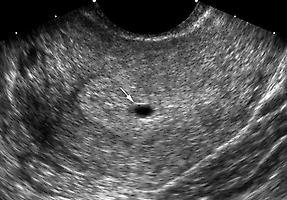
From 5 to 6 weeks' gestation, two methods can be used to assign gestational age by ultrasound: (1) measurement of mean sac diameter (MSD) or (2) sonographic identification of gestational sac contents. The MSD is calculated as the average of the anteroposterior diameter, the transverse diameter, and the longitudinal diameter. It increases from 2 mm at 5 weeks to 10 mm at 6 weeks, a growth pattern that can be used to assign gestational age during this period ( Table 42.1 ).
| MSD (mm) | Gestational Age (Weeks) |
|---|---|
| 2 | 5.0 |
| 3 | 5.1 |
| 4 | 5.2 |
| 5 | 5.4 |
| 6 | 5.5 |
| 7 | 5.6 |
| 8 | 5.7 |
| 9 | 5.9 |
| 10 | 6.0 |
The second method, based on the sonographic findings within the gestational sac, is best done by transvaginal sonography and relies on the observation that, on average, the gestational sac is first identifiable at 5.0 weeks, the yolk sac at 5.5 weeks ( Fig. 42.2 ), and the embryo and embryonic heartbeat at 6.0 weeks ( Fig. 42.3 , ). The timing of these milestones is subject to minimal variability, with a 95% confidence range of approximately 0.5 weeks. Gestational age can be assigned based on these milestones ( Table 42.2 ).

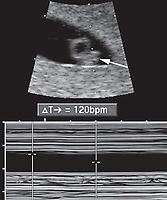
| Sonographic Finding | Gestational Age (Weeks) |
|---|---|
| Gestational sac, no yolk sac, embryo, or heartbeat | 5 |
| Gestational sac with yolk sac, no embryo or heartbeat | 5.5 |
| Gestational sac with heartbeat and embryo <5 mm in length | 6 |
| Embryo/fetus ≥5 mm in length | Age based on crown-rump length (see Table 42.3 ) |
From 6 weeks until the end of the first trimester, gestational age correlates closely with the crown-rump length (CRL) of the embryo or fetus. The term embryo is commonly used up to 10 weeks' gestation, and the term fetus applies thereafter. The CRL is the length of the embryo or fetus from the top of its head to the bottom of its torso. It is measured as the longest dimension of the embryo, excluding the yolk sac and extremities. From 9 or 10 weeks onward, the CRL measurements are most accurate if taken with the fetus in neutral position ( Fig. 42.4 ). The CRL can be used to assign gestational age accurately up to 14 weeks because there is little biologic variability in fetal length up until that age ( Table 42.3 ). After that point, the CRL of the longer, more developed fetus becomes less reliable. At this later stage, the CRL is affected by the fetal position, measuring shorter in a fetus whose spine is flexed and longer in a fetus whose spine is extended.

| CRL (mm) | Gestational Age (Weeks) | CRL (mm) | Gestational Age (Weeks) |
|---|---|---|---|
| 5 | 6.0 | 45 | 11.1 |
| 6 | 6.2 | 46 | 11.2 |
| 7 | 6.4 | 47 | 11.3 |
| 8 | 6.6 | 48 | 11.4 |
| 9 | 6.8 | 49 | 11.4 |
| 10 | 7.0 | 50 | 11.5 |
| 11 | 7.2 | 51 | 11.6 |
| 12 | 7.4 | 52 | 11.7 |
| 13 | 7.5 | 53 | 11.8 |
| 14 | 7.7 | 54 | 11.8 |
| 15 | 7.8 | 55 | 11.9 |
| 16 | 8.0 | 56 | 12.0 |
| 17 | 8.1 | 57 | 12.1 |
| 18 | 8.3 | 58 | 12.2 |
| 19 | 8.4 | 59 | 12.2 |
| 20 | 8.5 | 60 | 12.3 |
| 21 | 8.7 | 61 | 12.4 |
| 22 | 8.8 | 62 | 12.4 |
| 23 | 8.9 | 63 | 12.5 |
| 24 | 9.0 | 64 | 12.6 |
| 25 | 9.1 | 65 | 12.7 |
| 26 | 9.3 | 66 | 12.7 |
| 27 | 9.4 | 67 | 12.8 |
| 28 | 9.5 | 68 | 12.9 |
| 29 | 9.6 | 69 | 12.9 |
| 30 | 9.7 | 70 | 13.0 |
| 31 | 9.8 | 71 | 13.1 |
| 32 | 9.9 | 72 | 13.2 |
| 33 | 10.0 | 73 | 13.2 |
| 34 | 10.1 | 74 | 13.3 |
| 35 | 10.2 | 75 | 13.4 |
| 36 | 10.3 | 76 | 13.4 |
| 37 | 10.4 | 77 | 13.5 |
| 38 | 10.5 | 78 | 13.5 |
| 39 | 10.6 | 79 | 13.6 |
| 40 | 10.7 | 80 | 13.7 |
| 41 | 10.8 | ||
| 42 | 10.8 | ||
| 43 | 10.9 | ||
| 44 | 11.0 |
Many sonographic parameters have been proposed for estimating gestational age in the second and third trimesters. These include several fetal measurements: biparietal diameter (BPD), head circumference (HC), abdominal circumference (AC), femur length (FL), as well as combinations of two or more fetal measurements: the corrected-BPD and composite age formulas. Measurements of structurally abnormal fetal body parts should not be used in the assignment of gestational age.
Three measurements or parameters involve the fetal head: BPD, occipitofrontal diameter (OFD), and HC. All three measurements are taken from transaxial sonograms of the fetal head at the level of the paired thalami and cavum septi pellucidi ( Fig. 42.5 ). These head measurements are most accurate if the image is a true axial plane demonstrating the head as oval with symmetry of the thalami and cerebral hemispheres and without visualization of the posterior fossa. The BPD is measured from the outer edge of the cranium nearest the transducer to the inner edge of the cranium farthest from the transducer (“leading edge to leading edge”) ( Fig. 42.5 ). The OFD is obtained from the same transaxial image as the BPD and is measured from mid-skull to mid-skull along the long axis of the fetal head ( Fig. 42.5 ). This latter measurement is used in conjunction with the BPD to calculate the corrected-BPD using the following formula :
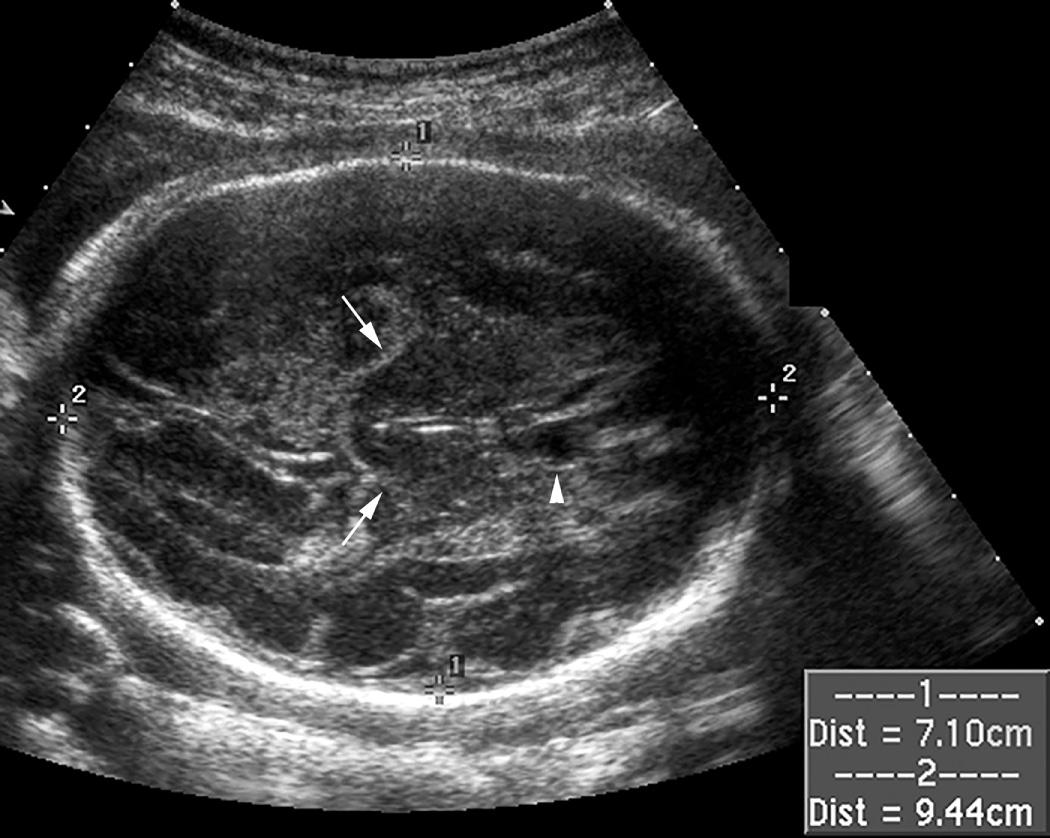
The rationale for the corrected-BPD is that it represents the BPD of the standard-shaped head (one with an OFD/BPD ratio of 1.265) of the same cross-sectional area. The same tables or formulas used to determine gestational age from the BPD are used to determine gestational age from the corrected-BPD ( Table 42.4 ).
| BPD OR BPDc (mm) | Gestational Age (Weeks) | BPD OR BPDc (mm) | Gestational Age (Weeks) |
|---|---|---|---|
| 20 | 13.2 | 60 | 24.2 |
| 21 | 13.4 | 61 | 24.5 |
| 22 | 13.6 | 62 | 24.9 |
| 23 | 13.8 | 63 | 25.3 |
| 24 | 14.0 | 64 | 25.7 |
| 25 | 14.3 | 65 | 26.1 |
| 26 | 14.5 | 66 | 26.5 |
| 27 | 14.7 | 67 | 26.9 |
| 28 | 14.9 | 68 | 27.3 |
| 29 | 15.1 | 69 | 27.7 |
| 30 | 15.4 | 70 | 28.1 |
| 31 | 15.6 | 71 | 28.5 |
| 32 | 15.8 | 72 | 29.0 |
| 33 | 16.1 | 73 | 29.4 |
| 34 | 16.3 | 74 | 29.9 |
| 35 | 16.6 | 75 | 30.3 |
| 36 | 16.8 | 76 | 30.8 |
| 37 | 17.1 | 77 | 31.2 |
| 38 | 17.3 | 78 | 31.7 |
| 39 | 17.6 | 79 | 32.2 |
| 40 | 17.9 | 80 | 32.7 |
| 41 | 18.1 | 81 | 33.2 |
| 42 | 18.4 | 82 | 33.7 |
| 43 | 18.7 | 83 | 34.2 |
| 44 | 19.0 | 84 | 34.7 |
| 45 | 19.3 | 85 | 35.2 |
| 46 | 19.6 | 86 | 35.8 |
| 47 | 19.9 | 87 | 36.3 |
| 48 | 20.2 | 88 | 36.9 |
| 49 | 20.5 | 89 | 37.4 |
| 50 | 20.8 | 90 | 38.0 |
| 51 | 21.1 | 91 | 38.6 |
| 52 | 21.4 | 92 | 39.2 |
| 53 | 21.7 | 93 | 39.8 |
| 54 | 22.1 | 94 | 40.4 |
| 55 | 22.4 | 95 | 41.0 |
| 56 | 22.8 | 96 | 41.6 |
| 57 | 23.1 | ≥97 | 42.0 |
| 58 | 23.5 | ||
| 59 | 23.8 |
The HC is the length of the outer perimeter of the cranium, made on the same transaxial image of the fetal head. It can be measured by using an electronic ellipse ( Fig. 42.6 , Table 42.5 ) or calculated from the outer-edge-to-outer-edge analogs of the BPD and OFD:
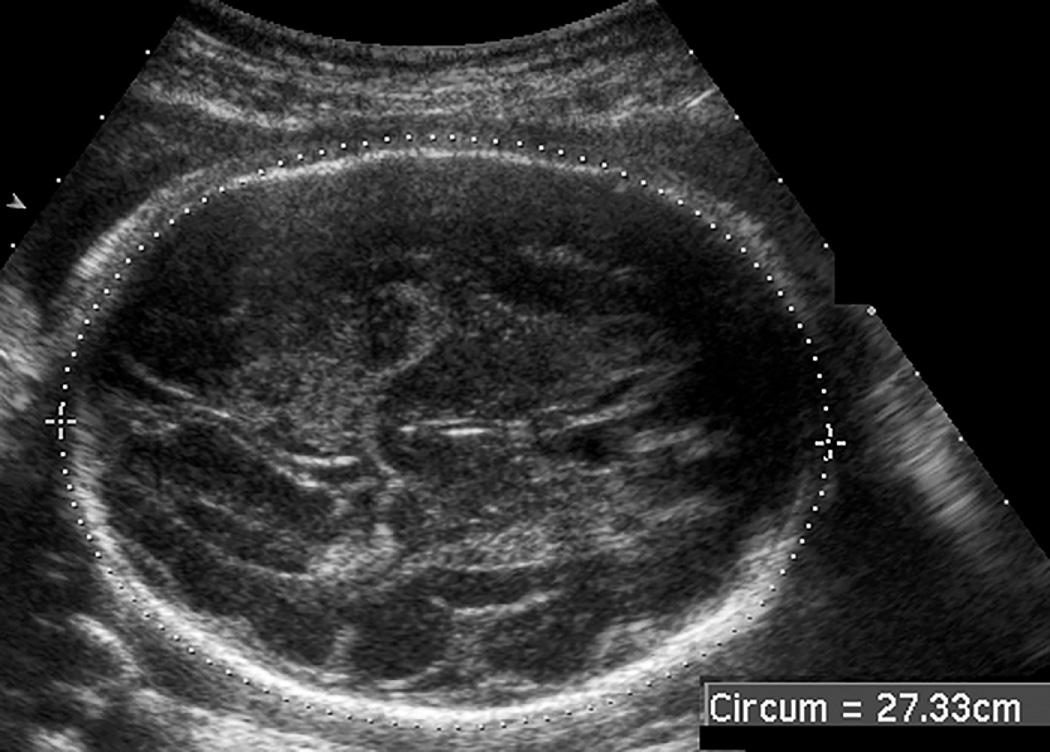
| HC (mm) | Gestational Age (Weeks) | HC (mm) | Gestational Age (Weeks) |
|---|---|---|---|
| 80 | 13.4 | 225 | 24.5 |
| 85 | 13.7 | 230 | 25.0 |
| 90 | 14.0 | 235 | 25.5 |
| 95 | 14.3 | 240 | 26.1 |
| 100 | 14.7 | 245 | 26.6 |
| 105 | 15.0 | 250 | 27.1 |
| 110 | 15.3 | 255 | 27.7 |
| 115 | 15.6 | 260 | 28.3 |
| 120 | 16.0 | 265 | 28.9 |
| 125 | 16.3 | 270 | 29.4 |
| 130 | 16.6 | 275 | 30.0 |
| 135 | 17.0 | 280 | 30.7 |
| 140 | 17.3 | 285 | 31.3 |
| 145 | 17.7 | 290 | 31.9 |
| 150 | 18.1 | 295 | 32.6 |
| 155 | 18.4 | 300 | 33.3 |
| 160 | 18.8 | 305 | 33.9 |
| 165 | 19.2 | 310 | 34.6 |
| 170 | 19.6 | 315 | 35.3 |
| 175 | 20.0 | 320 | 36.1 |
| 180 | 20.4 | 325 | 36.8 |
| 185 | 20.8 | 330 | 37.6 |
| 190 | 21.3 | 335 | 38.3 |
| 195 | 21.7 | 340 | 39.1 |
| 200 | 22.2 | 345 | 39.9 |
| 205 | 22.6 | 350 | 40.7 |
| 210 | 23.1 | 355 | 41.6 |
| 215 | 23.6 | 360 | 42.4 |
| 220 | 24.0 |
Although the BPD is simpler to measure than the corrected-BPD or HC, it has the disadvantage of being the only one of the three measurements that disregards head shape. This means that two heads of equal widths but different lengths will have the same BPD, but the longer head will have a greater corrected-BPD and HC than the shorter head ( Fig. 42.7 ). The fetus with the longer head will therefore be assigned a greater gestational age based on the corrected-BPD or HC; however, both fetuses will be assigned the same gestational age if the BPD is used as the basis for age assignment.
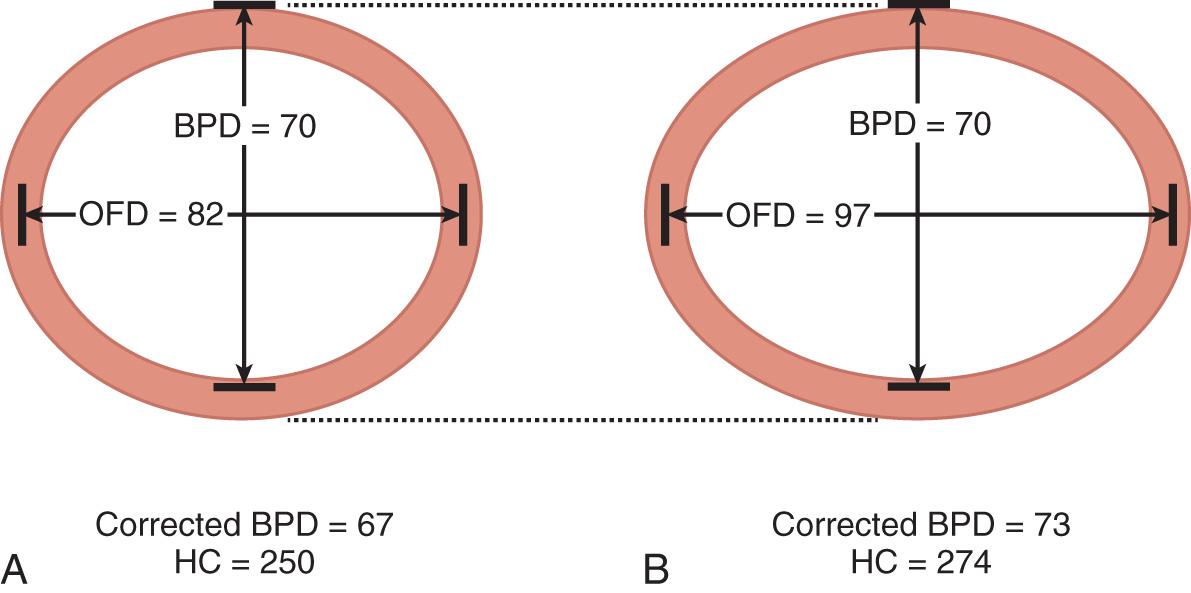
The length of the ossified diaphysis of the fetal femur is often used for gestational age estimation. Careful measurement technique is necessary to obtain an accurate estimate of gestational age by FL ( Fig. 42.8 , Table 42.6 ). The transducer must be aligned to the long axis of the diaphysis, perpendicular to the beam, with both ends of the ossified diaphysis appearing squared off. The cursors should be positioned at the junction of the echogenic bone with the hypoechoic cartilage, and the thin, bright reflection of the cartilaginous epiphysis should not be included in the measurement.

| FL (mm) | Gestational Age (Weeks) | FL (mm) | Gestational Age (Weeks) |
|---|---|---|---|
| 10 | 13.7 | 45 | 24.5 |
| 11 | 13.9 | 46 | 24.9 |
| 12 | 14.2 | 47 | 25.3 |
| 13 | 14.4 | 48 | 25.7 |
| 14 | 14.6 | 49 | 26.2 |
| 15 | 14.9 | 50 | 26.6 |
| 16 | 15.1 | 51 | 27.0 |
| 17 | 15.4 | 52 | 27.5 |
| 18 | 15.6 | 53 | 28.0 |
| 19 | 15.9 | 54 | 28.4 |
| 20 | 16.2 | 55 | 28.9 |
| 21 | 16.4 | 56 | 29.4 |
| 22 | 16.7 | 57 | 29.9 |
| 23 | 17.0 | 58 | 30.4 |
| 24 | 17.3 | 59 | 30.9 |
| 25 | 17.6 | 60 | 31.4 |
| 26 | 17.9 | 61 | 31.9 |
| 27 | 18.2 | 62 | 32.5 |
| 28 | 18.5 | 63 | 33.0 |
| 29 | 18.8 | 64 | 33.6 |
| 30 | 19.1 | 65 | 34.1 |
| 31 | 19.4 | 66 | 34.7 |
| 32 | 19.7 | 67 | 35.3 |
| 33 | 20.1 | 68 | 35.9 |
| 34 | 20.4 | 69 | 36.5 |
| 35 | 20.7 | 70 | 37.1 |
| 36 | 21.1 | 71 | 37.7 |
| 37 | 21.4 | 72 | 38.3 |
| 38 | 21.8 | 73 | 39.0 |
| 39 | 22.2 | 74 | 39.6 |
| 40 | 22.5 | 75 | 40.3 |
| 41 | 22.9 | 76 | 40.9 |
| 42 | 23.3 | 77 | 41.6 |
| 43 | 23.7 | ≥78 | 42.0 |
| 44 | 24.1 |
The fetal AC is the length of the outer perimeter of the fetal abdomen, measured on transverse view at the level of the intrahepatic portion of the umbilical vein. Ideally the stomach will also be visible ( Fig. 42.9 ). Ideally, the abdomen should appear round. The level chosen should demonstrate only a short segment of the umbilical vein in the anterior third of the liver. Measurement of the AC involves placing the ellipse along the outer skin surface ( Fig. 42.9A ). Alternatively, the AC may be calculated from two orthogonal abdominal diameters (AD 1 , AD 2 ), one anteroposterior and the other transverse ( Fig. 42.9B ), measured on the same image, as follows :
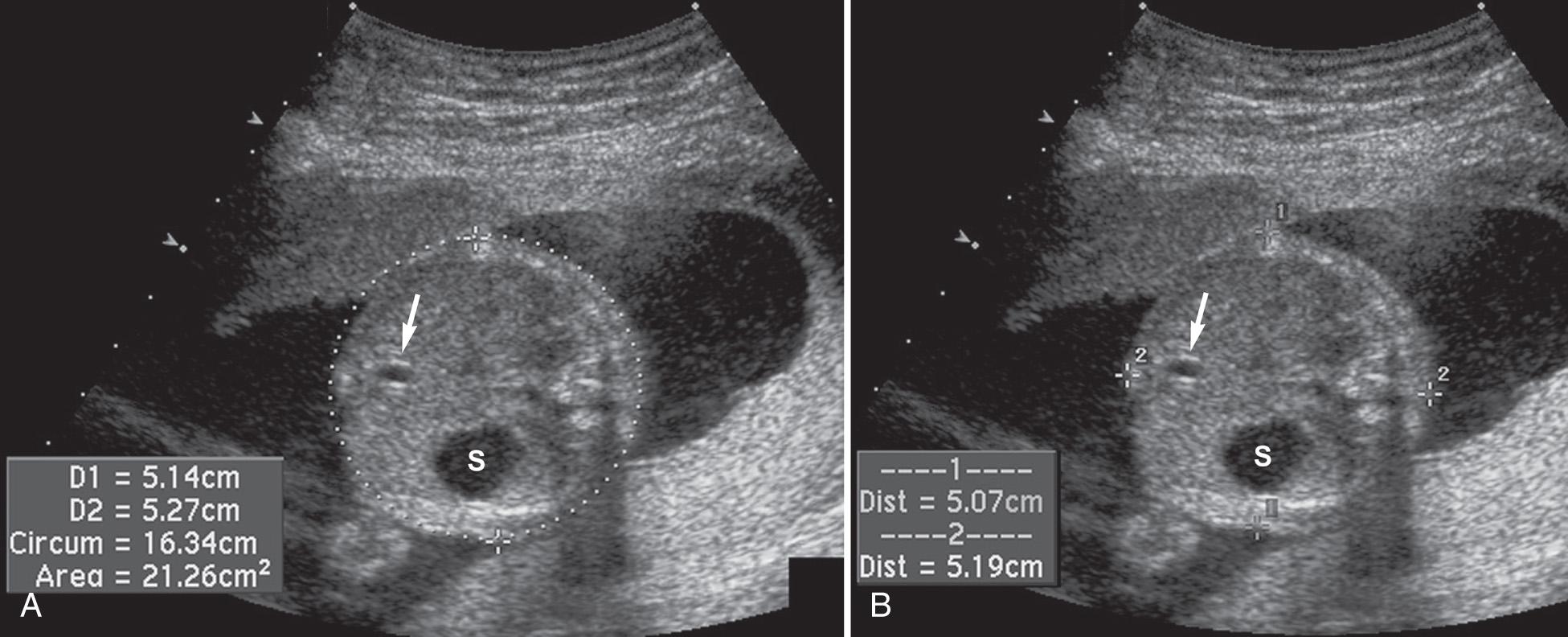
Gestational age can be estimated from measurements of the head, abdomen, or femur by means of tables or formulas that present the mean value of each measurement for a given gestational age ( Tables 42.4 to 42.6 ). Composite age formulas that combine several fetal measurements can also be used to estimate gestational age.
Because composite age formulas use a combination of two or more measurements in conjunction to estimate gestational age, a potential disadvantage of using such formulas is that an abnormal measurement or anomaly might be obscured. For example, in a fetus with a skeletal dysplasia manifested by shortened long bones and a normal head size, the gestational age based on the composite formula will be an underestimation, falling between that predicted by the HC and that predicted by the short FL. As a result, the FL might not appear to be abnormally small when compared to this improperly calculated gestational age.
When sonographic, as opposed to clinical, dating is used to assign gestational age, it is important to use the most accurate method or measurement available ( Table 42.7 ). This is most relevant at the time of the initial scan in a woman's pregnancy, since, as noted previously, it is inappropriate to reassign gestational age at the time of the second or subsequent scan during the pregnancy.
| Stage of Pregnancy | Basis for GA | Tables | Accuracy (Weeks) a |
|---|---|---|---|
| FIRST TRIMESTER | |||
| Early (5-6 weeks) | Mean sac diameter or sonographic findings | 42.1, 42.2 | ±0.5 |
| Mid to late (6-13 weeks) | CRL | 42.3 | ±0.7 |
| SECOND TRIMESTER | |||
| If OFD measurable | BPDc or HC | 42.4, 42.5 | ±1.2 (14-20 weeks) |
| ±1.9 (20-26 weeks) | |||
| If OFD not measurable | BPD or FL | 42.4, 42.6 | ±1.4 (14-20 weeks) |
| ±2.1-2.5 (20-26 weeks) | |||
| THIRD TRIMESTER | |||
| If OFD measurable | BPDc, HC, or FL | 42.4, 42.5, 42.6 | ±±3.1-3.4 (26-32 weeks) |
| ±±3.5-3.8 (32-42 weeks) | |||
| If OFD not measurable | FL | 42.6 | ±±3.1 (26-32 weeks) |
| ±±3.5 (36-42 weeks) | |||
a Two standard deviations (2 SD) or 95% confidence interval (CI).
If the initial scan is performed in the early first trimester, when ultrasound demonstrates no embryo or an embryo less than 5 mm in length, two approaches to gestational age assignment are equal in accuracy, both with 95% confidence ranges of ±0.5 weeks: date the pregnancy based on MSD (see Table 42.1 ) or on sac contents (see Table 42.2 ). For the rest of the first trimester, when the CRL measures 5 to 80 mm, dating based on CRL (see Table 42.3 ) is very accurate, with a 95% confidence range of ±0.7 weeks.
In the second and third trimesters, there are several options for sonographic dating, including measurements of the head, femur, or abdomen, as well as composite formulas based on measurements of two or more of these. When both the width and length of the head (BPD and OFD) are visible, the optimal approach to sonographic age assignment in the second trimester is to use either the corrected-BPD or the HC, and, in the third trimester, use the corrected-BPD, the HC, or the FL. When either the anterior or posterior aspects of the cranium are not well seen on ultrasound, so that the OFD and HC cannot be measured accurately, it is best to date based on the BPD or FL in the second trimester and on the FL in the third trimester. These approaches are the most accurate single-body-part sonographic dating methods and are preferable to composite age formulas for reasons presented earlier.
Before the availability of ultrasound, manual examination of the maternal abdomen was the approach used to estimate fetal size. The physical examination, however, provides only a general approximation of fetal weight because the palpated dimensions of the uterus are affected by several factors other than fetal size, including amniotic fluid volume, presence of fibroids, and maternal obesity.
Sonographic measurements of fetal body parts provide a direct way of assessing fetal weight and are used mainly in the third trimester. The approach to fetal weight estimation and assessment involves a number of steps: (1) estimate the fetal weight based on fetal measurements; (2) estimate the gestational age using the approach described earlier; (3) determine the weight percentile for gestational age using a formula or chart of weight norms as a function of gestational age; (4) if the fetus is above the 90th percentile or above 4000 g estimated weight, consider options for route of delivery; (5) if the weight is at or below the 10th percentile, attempt to determine whether the fetus is constitutionally small or small because of a pathologic etiology, then manage the pregnancy accordingly.
Numerous formulas have been published for estimating fetal weight based on sonographic measurements, most of which use one or more of these fetal body parts: head (BPD or HC), abdomen (AD or AC), and femur (FL). Other measurements, such as thigh circumference, have been used as well. Formulas that estimate fetal weight using three-dimensional (3D) sonography and 3D magnetic resonance imaging (MRI) have also been published.
The accuracy of a weight prediction formula is determined by assessing how well the formula works in a group of fetuses scanned close to delivery. An important measure of a formula's performance is its 95% confidence range. If the 95% confidence range is ±18%, for example, the estimated weight will fall within 18% of the actual weight in 95% of cases, and the error will be greater than 18% in only 5% of cases. The narrower the confidence range is, the more reliable is the formula.
Many published studies provide information on this measure of a formula's accuracy ( Table 42.8 ). The following points are noteworthy:
The accuracy of weight prediction formulas improves as the number of measured body parts increases up to three, achieving greatest accuracy when measurements of the head, abdomen, and femur are used. There is no apparent improvement by adding the thigh circumference as a fourth measurement and no proven benefit from using 3D sonography or MRI.
Even when based on measurements of the head, abdomen, and femur, sonographic weight prediction has a rather wide 95% confidence range of at least ±15%. Based on the abdomen and either the head or femur, the range is at least ±16% to 18%. Precision is considerably worse when only the abdomen is used.
A number of factors have been studied to determine their effect on accuracy of weight prediction. Accuracy appears to be worse in fetuses that weigh less than 1000 g than in larger fetuses. Over the rest of the birth weight range, however, accuracy is fairly constant. Weight prediction is less accurate in diabetic than in nondiabetic mothers: in diabetic mothers, formulas that use measurements of the head, abdomen, and femur have a 95% confidence range of ±24%, wider than the range of ±15% in the general population. The presence of oligohydramnios or polyhydramnios has no impact on accuracy. Scan quality may have an effect on accuracy. Studies have shown a trend toward greater accuracy in scans that were rated “good” compared with those rated “poor” based on ability to visualize anatomic landmarks.
| Body Part(s) Included in Formula | Formula | 95% Confidence Range (%) a |
|---|---|---|
| Abdomen | Campbell and Wilkin | ±17.1-23.8 |
| Higginbottom et al. | ±23.8 | |
| Hadlock et al. | ±22.2 | |
| Vintzileos et al. | ±22.8 | |
| Head and abdomen | Warsof et al. | ±17.4-21.2 |
| Shepard et al. | ±18.2-18.3 | |
| Thurnau et al. | ±19.8 | |
| Jordaan | ±25.8 | |
| Hadlock et al. | ±18.2 | |
| Hadlock et al. | ±18.2 | |
| Birnholz | ±17.7 , b | |
| Vintzileos et al. | ±21.2 | |
| Abdomen and femur | Hadlock et al. | ±16.4 |
| Hadlock et al. | ±16.0 | |
| Head, abdomen, and femur | Hadlock et al. | ±15.0-15.4 |
| Hadlock et al. | ±14.8-15.0 | |
| Vintzileos et al. | ±17.6 | |
| Head, abdomen, femur, and thigh | Vintzileos et al. | ±15.6-17.8 |
a Computed as two standard deviations (2 SD) of the relative error, as reported in the study(ies) referenced, unless otherwise indicated.
b Based on the fraction of cases in which the estimated weight falls within 10% of the actual weight.
An attempt should be made to image all three key fetal anatomic regions—head, abdomen, and femur—at the appropriate anatomic levels ( Table 42.9 ). If measurements of all three structures can be obtained, Formula 1 in Table 42.9 should be used to estimate fetal weight. This formula should be used with the corrected-BPD when the OFD is available, and with the BPD itself if not. An alternative approach, equally accurate but more cumbersome, would be to use Formula 1 when the OFD is unavailable, and a formula based on HC, AC, and FL when the OFD is available. If the abdomen and only one of the head or the femur can be appropriately imaged, Formula 2 or 3 should be used. If the abdomen cannot be measured, or both the head and femur cannot be measured, then a weight estimate should not be calculated. Using the approach outlined in Table 42.9, an accuracy of ±15% to 18% can be achieved for weight estimation.
| Body Parts Imaged | Formula Used for Weight Estimate |
|---|---|
| HEAD, ABDOMEN, AND FEMUR | |
| OFD measurable | Formula 1, using corrected-BPD in place of BPD |
| OFD not measurable | Formula 1 |
| HEAD AND ABDOMEN | |
| OFD measurable | Formula 2, using corrected-BPD in place of BPD |
| OFD not measurable | Formula 2 |
| ABDOMEN AND FEMUR | |
| — | Formula 3 |
| FORMULA 1 a | |
| FORMULA 2 a | |
| FORMULA 3 a | |
a Formulas from Hadlock FP, Harrist RB, Sharman RS, et al. Estimation of fetal weight with the use of head, body, and femur measurements—a prospective study. Am J Obstet Gynecol. 1985;151(3):333-337.
When an ultrasound is performed in the third trimester, best estimates of gestational age and fetal weight should be established. The gestational age may be based on a prior ultrasound, clinical dating criteria, or current measurements; fetal weight is always calculated from current measurements. The two values should be assessed in relation to one another to determine whether the fetus is appropriate in size for dates. This can be accomplished by using a table that provides norms for fetal weight as a function of gestational age ( Table 42.10 ), several of which appear in the literature.
| WEIGHT PERCENTILES (GRAMS) | |||
|---|---|---|---|
| Gestational Age (Weeks) | 10th | 50th | 90th |
| 25 | 490 | 660 | 889 |
| 26 | 568 | 760 | 1016 |
| 27 | 660 | 875 | 1160 |
| 28 | 765 | 1005 | 1322 |
| 29 | 884 | 1153 | 1504 |
| 30 | 1020 | 1319 | 1706 |
| 31 | 1171 | 1502 | 1928 |
| 32 | 1338 | 1702 | 2167 |
| 33 | 1519 | 1918 | 2421 |
| 34 | 1714 | 2146 | 2687 |
| 35 | 1919 | 2383 | 2959 |
| 36 | 2129 | 2622 | 3230 |
| 37 | 2340 | 2859 | 3493 |
| 38 | 2544 | 3083 | 3736 |
| 39 | 2735 | 3288 | 3952 |
| 40 | 2904 | 3462 | 4127 |
| 41 | 3042 | 3597 | 4254 |
| 42 | 3142 | 3685 | 4322 |
| 43 | 3195 | 3717 | 4324 |
There is some debate about a number of aspects of fetal weight assessment in relation to gestational age. Should a weight table or chart based on neonatal weights or on estimated fetal weights be used? Should the table or chart be derived solely from pregnancies of low-risk mothers? Should “population norms” or “customized norms” be used?
Most weight norms (tables or charts) are derived from large data sets of neonatal birth weights from babies born at a known gestational age. At least one chart, on the other hand, was produced using estimated fetal weights instead of neonatal birth weights. A rationale for the latter is that several studies have shown that fetuses that deliver preterm are smaller, on average, than those of the same gestational age that remain in utero. Babies born preterm thus represent an abnormal group with a negatively skewed weight distribution. This supports the argument that fetuses should be compared to fetuses, not to babies.
A large international study, INTERGROWTH-21st, used another approach to produce weight norms derived from a healthy population. Although it is based on birth weights rather than fetal weights, the study population used to generate these norms consists of babies born at or beyond 33 weeks to mothers with no known pregnancy-related risk factors. The INTERGROWTH-21st norms, however, are of limited use for assessing fetal weight in relation to gestational age, because they do not cover the period prior to 33 weeks' gestation.
Perhaps the biggest controversy in weight assessment is whether the estimated weight of a fetus should be compared to norms from the overall population or to customized norms derived from a subgroup of fetuses similar to that fetus. For example, if an African-American fetus has an estimated weight of 1200 g at 30 weeks' gestation, should the weight percentile be determined from overall population norms or from African-American norms? In that example, the population-based percentile would be lower than the customized percentile, because African-American fetuses and neonates are smaller, on average, than those in the general population. Although there are proponents of customized norms, a major concern with this approach is that it can do harm by inadvertently normalizing the weight of a fetus who is small on a pathologic basis. This viewpoint is supported by the fact that at least some population groups with small babies have elevated rates of postnatal complications and by the INTERGROWTH-21st finding that neonates of healthy mothers do not differ in size based on ethnic background.
Overall, our recommended approach is to use population norms. Although it would theoretically be preferable to use norms derived from estimated fetal weights, norms derived from birth weights are better established and are based on larger study populations.
The weight gain between two ultrasound examinations can be estimated as the difference between the two estimated weights. Adequacy of weight gain can be assessed by comparing this difference to established normal fetal growth rate as a function of gestational age. INTERGROWTH-21st data indicate that median fetal weight gain per week decreases progressively from 33 weeks of gestation onward, with a maximum rate of 270 g per week at 33 weeks, down to 100 g per week at 41 weeks. Other older growth tables suggest that weight gain may increase until 36 weeks, then decline steadily thereafter. The longer the time is between scans, the more accurate the sonographic estimate of interval weight gain will be. When two scans are performed within 1 week of each other, weight gain cannot be determined reliably, because weight prediction is too imprecise to detect small changes in growth. Furthermore, estimating weight too close to the time of the prior scan could raise unnecessary concern by a spurious finding that the fetus has grown subnormally or even lost weight. Thus there is little or no value in computing an estimated weight at the time of the second scan 1 week after the first. Instead, it is recommended that fetal weight gain only be assessed after an interval of at least 2 weeks' duration.
When several examinations have been performed, fetal growth can be depicted graphically by means of a trend plot or growth curve. One form of growth curve plots the estimated fetal weight versus gestational age, with the curve for the fetus being examined superimposed on lines depicting the 1st, 10th, 50th, 90th, and 99th percentiles ( Fig. 42.10A ). An alternative mode of display plots the estimated fetal weight percentile versus gestational age ( Fig. 42.10B ). In this latter format, the graph for a normally growing fetus will be a horizontal line, indicating maintenance of a particular weight percentile throughout gestation. A down sloping line suggests subnormal growth rate.
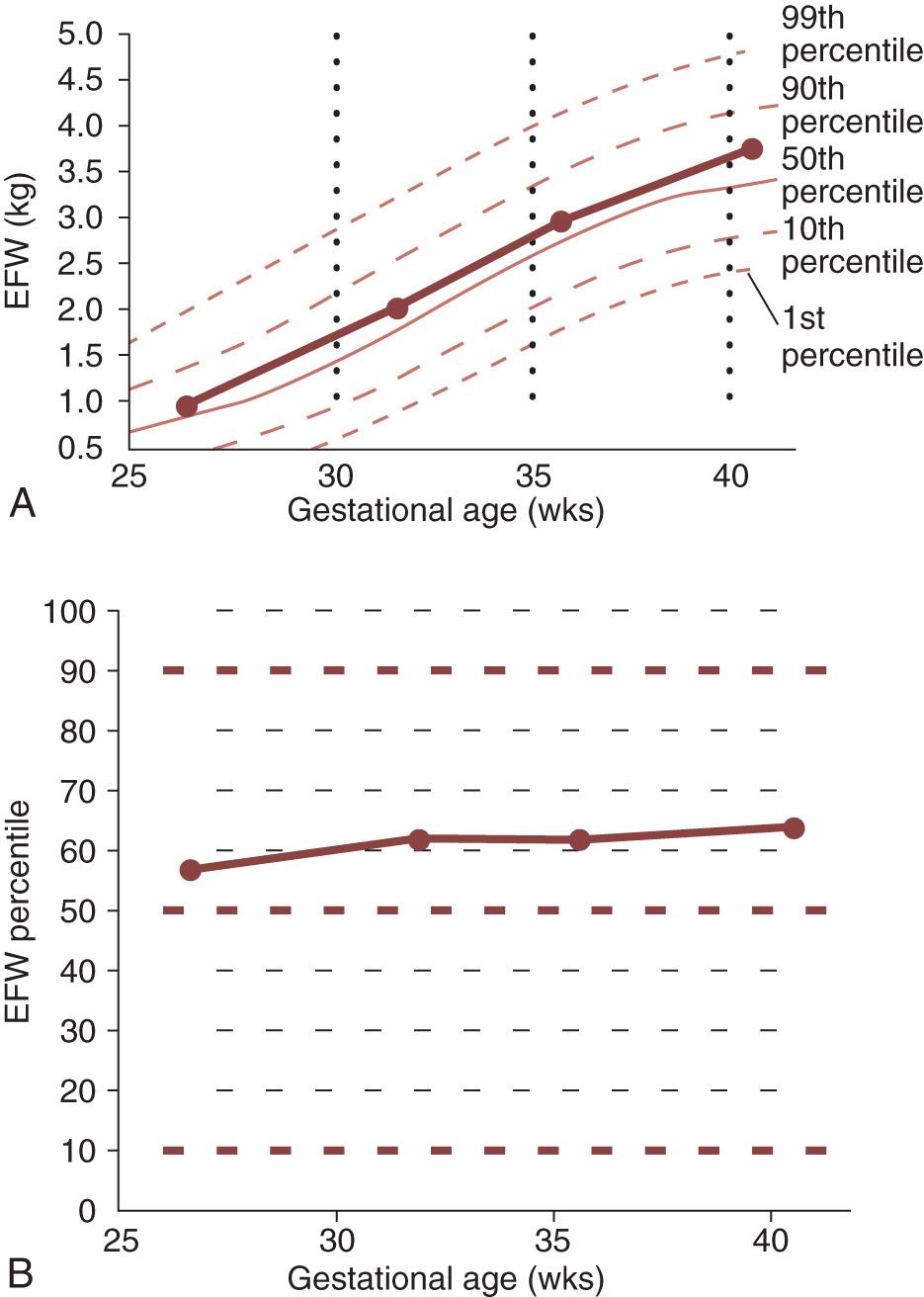
Calculation of weight percentiles and plotting of growth curves are most easily accomplished by computer, using an obstetric ultrasound software package that performs these tasks. Alternatively, similar results can be achieved by means of a calculator and manual plotting of data.
Become a Clinical Tree membership for Full access and enjoy Unlimited articles
If you are a member. Log in here